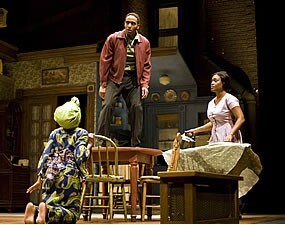'Raisin' Hell

"A Raisin in the Sun" is one of those black works of art so iconic, I was sure I'd seen it at some point in my life. After all, I had read the script, performed scenes (back when I had youthful ideas of becoming an actor and 'Raisin' was the go-to audition piece to convince agents and the like of both your artistic seriousness and wider mission of social change), read countless analyses and references in essays, articles, even poetry. Its more radical lines (rebellious Beneatha Younger declaring "I hate assimilationist Negroes!") might even be incorporated somehow, somewhere, on a hip-hop track. The play and its place in black history--a frank-talking family drama/racial allegory that debuted on Broadway in 1959 on the cusp of the civil rights movement and its attempt to finally wrestle slavery's monstrous legacy to the ground--is unavoidable for any casual student of black letters or theater. I had it covered.
But I found out last week that I absolutely didn't. Sitting through a matinee of a very impressive "Raisin in the Sun," presented by the Ebony Repertory Theatre at the Nate Holden Performing Arts Center, it struck me that I had never seen the show. Reading the script, however brilliant, is a far different experience than hearing that script and seeing it on its feet, and realizing that the most electric moments on stage almost always have nothing to do with words at all. And there was the communal experience of sitting with folks in a darkened theater caught up in the story of a poor black Chicago family in the '40s whose struggle to move up and out of the tomb-like Southside ghetto resonated all too clearly in 2011. True, most of the crowd were members of the gilded black middle class that was the stuff of the Younger family's fantasy, its projection of a bright future for themselves and for the entire race.
But it was clear that the Youngers and the desperation they embodied were a kind of mirror held up to this middle class sixty years on; the gasps and murmurs of consternation from the audience throughout the show suggested that poverty and dissatisfaction was only a few degrees removed from our own families, if indeed it was removed at all. A row of women sitting in front of me, decked out in church finery that included sequined red hats, kept whispering urgently to each other at key moments that Walter had better watch out with his money, Beneatha had better behave, etc., as if what they were seeing was not fiction set in a distant past but a kind of reality show. For these women, and for the rest of us, the 'Raisin' characters and their quandaries lived, and not just as voyeuristic entertainment per most reality shows, but as a call to action and reflection.
The play got thunderous ovations at the end. It deserved them. But the faces of the theatergoers filing out were more than a little shell-shocked. We had been transported, something good theater will do. But what had we come back to? Geography and climate notwithstanding, how many degrees really separate the Southside and South Central? The show goes on.
Journalist and op-ed columnist Erin Aubry Kaplan's first-person accounts of politics and identity in Los Angeles, with an eye towards the city's African American community, appear every Thursday at 2 p.m. on KCET's SoCal Focus blog.


